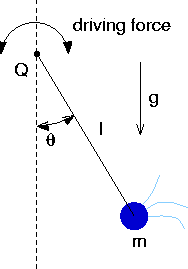A Chaotic Pendulum in Phase Space with Java
Suggested Explorations
- Try out all the tabulated cases and describe what's happening.
- Compare the motion of the two almost-identical pendula, and pick
out a particular point where the coordinate space motions begin to
differ.
- Compare the motion of the two almost-identical pendula, and note
in which way the phase-space motion of the two pendula appear similar even
though the coordinate space motions differ.
- Turn off the frictional and driving torques and identify the
phase-space figures which correspond to the natural oscillations of
the system.
- Describe how the phase-space shapes of the natural oscillations
change as the initial velocity is made greater and greater.
- Turn off the driving torque, but not friction, and describe the
shape of the
phase-space figures.
- Identify which physical motions of the pendulum lead to
particular shapes in phase space.
- In what direction (clockwise or counter clockwise)
does the pendulum travel in phase space?
- What happens in phase space when the pendulum goes "over the top"
in coordinate space?
- How can you tell in phase space if the pendulum is swinging
clockwise or counter clockwise in coordinate space?
- Identify which parts of the orbit are transients and
which parts are attractors.
- Try to find a limit cycle in which the average energy
put into the system during one cycle exactly balances the average
energy dissipated by friction during that cycle.
- Make the driving torque so large that it overpowers the natural
oscillations of the pendulum and the steady-state motion is at the
frequency of the driver. This is an example of mode locking.
- Sweep the driver's frequency through the pendulum's natural
frequency and find resonances.
- Turn off friction and again sweep the driver's frequency through
the pendulum's natural frequency and find resonances.
- Look for resonances which also occur when the ratio of driver's
frequency to natural frequency is the ratio of integers.
Back: Main Page

